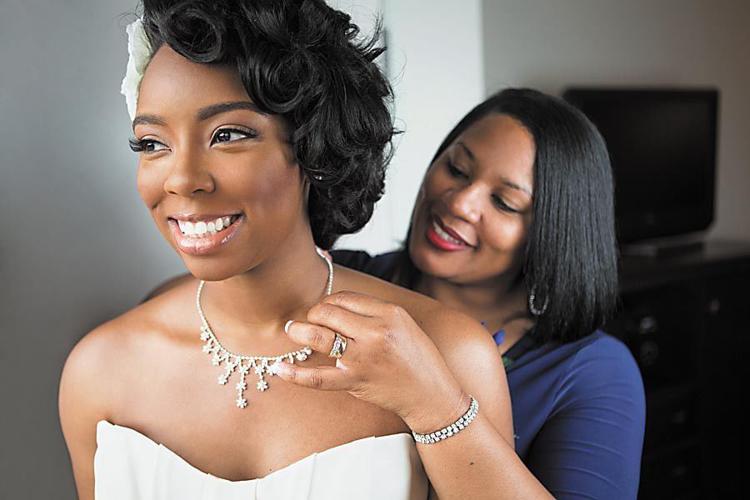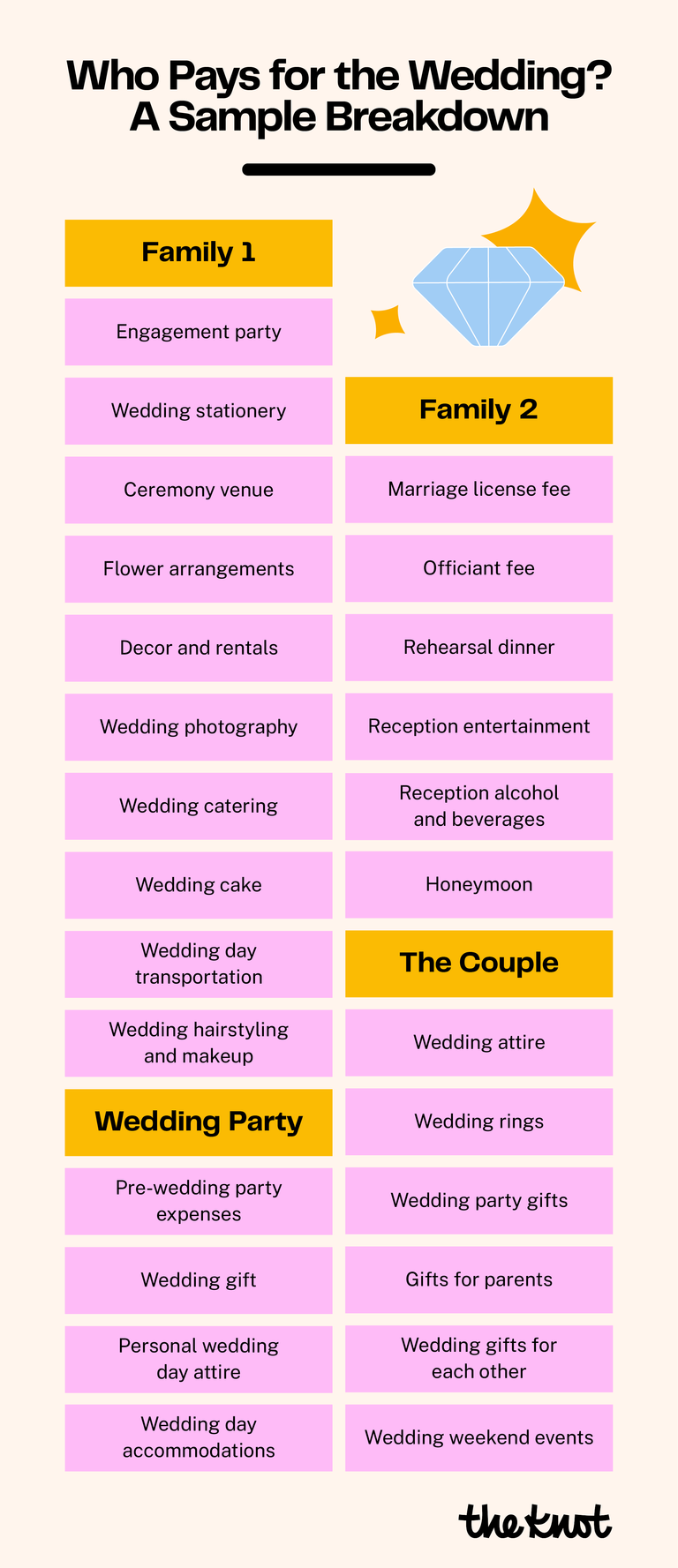Planning a wedding can be an exciting time, but it can also get expensive very quickly. Traditionally, certain parties have taken responsibility for different wedding costs and obligations. Understanding these traditions can help engaged couples budget and plan their dream wedding more smoothly.
In years past, the bride’s family paid for most wedding expenses. But times have changed, and now wedding costs are often shared between couples, families, and friends. This article will break down who traditionally pays for what in a wedding. We’ll also discuss some factors that can change the breakdown, like cultural traditions, blended families, and simple practicality.
The Wedding Venue and Catering
The wedding venue and catering (food and drink) are typically the biggest wedding expenses. Traditionally, the bride’s parents pay for these costs. However, in many modern weddings, the engaged couple pays for some or all of these expenses themselves.
If the bride’s parents are heavily involved in the wedding planning, they may choose the venue. The couple should give input as well. Sometimes the groom’s family offers to split the venue/catering costs with the bride’s family. Other times, the couple pays for their own venue. As wedding traditions blend with modern ideals, the breakdown varies quite a bit.
Potential Target Audiences
This article would appeal to several target audiences, including:
- Newly engaged couples planning a wedding
- Parents of engaged couples who want to know wedding spending traditions
- Wedding planners and coordinators
- Brides and grooms looking to split costs fairly
- Blended families navigating wedding planning
- Couples trying to budget wedding expenses
The topic is useful for anyone involved in planning a traditional wedding. It provides guidance on who pays for typical wedding costs based on etiquette and expectations.
The Rehearsal Dinner
After the ceremony site and catering, the rehearsal dinner is the next biggest expense. Traditionally, the groom’s parents host and pay for the rehearsal dinner. It’s usually held the night before the wedding after the rehearsal walk-through at the ceremony site.
However, sometimes wedding budgets are split in such a way that the bride’s family ends up hosting or contributing. Blended families can also share responsibilities for the rehearsal dinner.
The Wedding Rings
While the bride often gets an engagement ring from her fiancé, the couple usually splits the cost of the actual wedding rings. Some couples choose to closely match their rings, while others select totally different styles that reflect their personalities. From plain bands to diamond-studded designs, wedding rings are very personal.
Wedding Attire
The bride traditionally buys her own wedding dress, accessories, and bridal party gowns. However, some brides’ families offer to pitch in or pay for the wedding gown as a gift. The groom pays for his tuxedo or suit and the groomsmen’s outfits, but sometimes the bride covers accessories like ties and cufflinks. Flower girls’ dresses are usually paid for by the bride or her family.
Wedding Stationery
The invitations, save-the-dates, wedding programs, place cards, thank you notes, and any other wedding stationery are traditional paid for by the bride’s family. However, some couples cover these costs themselves, especially if they are planning an intricate letterpress suite or customized designs.
Flowers and Decor
Flowers can be a surprisingly costly wedding expense. Centerpieces, ceremony arrangements, bouquets, boutonnieres, corsages, aisle decor, and more add up fast. Traditionally the bride’s family handles floral expenses, but the groom’s family may offer to pitch in. Some couples also build floral costs into their overall budget.
Wedding Photography
Most couples today view professional wedding photography as a necessity, not a luxury. While photo and video costs used to fall under the bride’s family’s responsibilities, now the engaged couple usually pays for their own wedding photographer and videographer.
Ceremony and Reception Music
Music helps set the mood at wedding ceremonies and receptions, so it’s an important element. Traditionally the bride’s family pays for ceremony music, like a pianist, string quartet, soloist, or organist. The band or DJ that provides reception music has traditionally been paid for by either family or split between them both. But it’s common for engaged couples to cover this cost in their shared wedding budget.
Transportation
Guests and wedding parties need transportation getting to the ceremony, reception, hotels, and airports. Traditionally the bride’s family handles booking and paying for guest buses/shuttles, while the groom’s family books and pays for the newlywed’s getaway car. But couples often handle transportation logistics and expenses themselves these days.
The Wedding Cake
The wedding cake is full of symbolism about the couple’s future together, so it’s a significant part of receptions. The bride’s family traditionally pays for the wedding cake. However, some couples now factor it into their overall budget. Groom’s cake expenses may be covered by his family instead.
The Bar Tab
An open bar offering beer, wine, liquor, and non-alcoholic drinks is typical at most American weddings. Traditionally, the groom’s family pays for the reception bar expenses. But many brides’ families contribute, especially if they want certain premium liquors or champagne toast options. The couple often pitches in from their budget too.
Tips and Gifts
Good etiquette means tipping wedding vendors like photographers, bands/DJs, hair/makeup pros, coordinators, and transportation providers. Traditionally the bride’s family handles tips. The bride also tips bridesmaids with gifts for being in the wedding. And the couple usually exchanges personal gifts to each other the morning of the wedding.
Factors That Can Change the Breakdown
While those traditions provide a general guideline on who pays for what, there are many factors that can change the breakdown:
- Cultural or religious traditions may specify different funding responsibilities
- Blended families can share expenses in unique ways
- LGBTQ+ weddings may divide costs non-traditionally
- Couples getting married later in life may pay for more themselves
- Small or informal weddings may not follow all traditions
- Divorced parents may have different abilities or desires to contribute
- Some families give wedding costs as engagement or bridal shower gifts
The most important thing is communicating openly about wedding funding with all parties involved. Traditions provide helpful guidelines, but practicality and family dynamics also play a key role.
From the rehearsal dinner to wedding rings to floral arrangements, wedding expenses add up fast. There are well-established traditions about who pays for each wedding element.
Traditionally, the bride’s family serves as the main host and pays for most wedding costs. But today’s couples often contribute a significant portion themselves or split expenses with the groom’s family.
By understanding these wedding spending traditions, couples, parents, and planners can better budget for all the costs. Compromises and gifts from family along the way help ease some of the financial burden as well.




